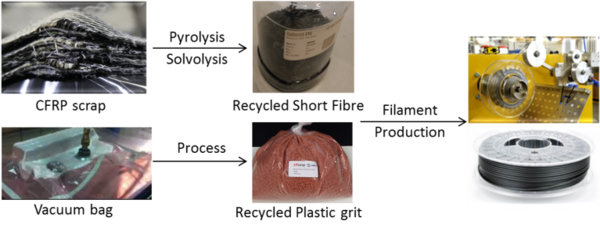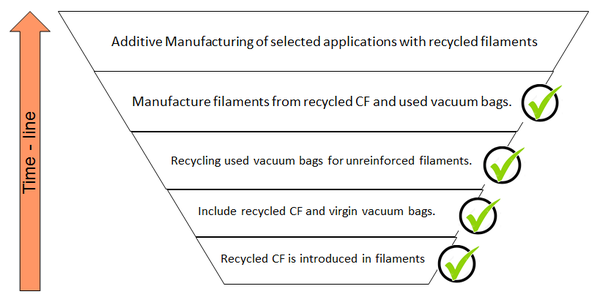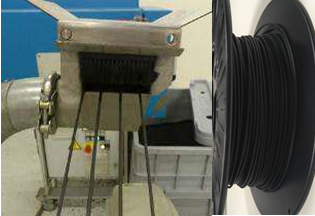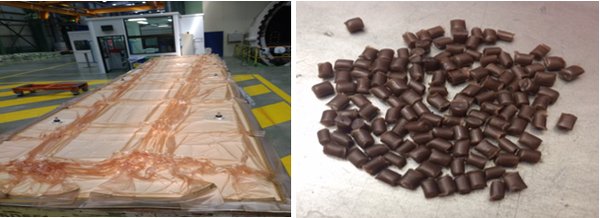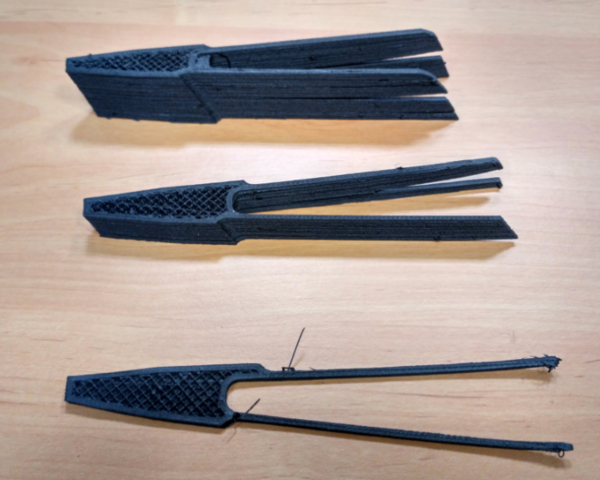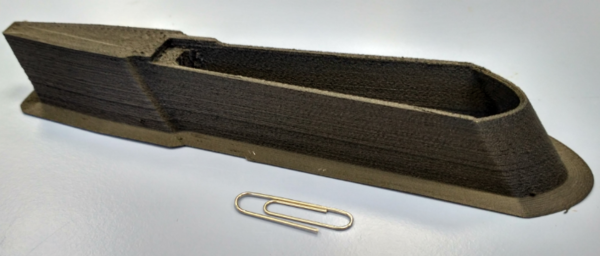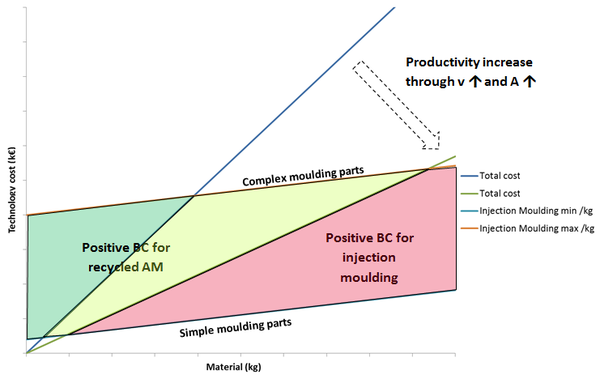1 Introduction
Today the massive application of carbon fiber reinforced polymers (CFRP) in our aircrafts is a fact. Best example is the last generation Airbus A350XWB, with a CFRP structural weight of around 53% (wings, fuselage…) and a high production rate (13 aircrafts per month). However, although current composite part manufacturing is highly automatic and efficient, the buy to fly ratio is still higher than one, meaning that part of the material used in production does not fly and becomes waste. Additionally, all aeronautical carbon fiber material parts are produced using a high quantity of auxiliary materials in order to obtain final shape in autoclave production, which are in most cases only used once, e.g. plastic films used as vacuum bags to obtain final aeronautical components.
All of this leads to several tons of carbon fiber materials and vacuum bag films scrapped every year in Airbus composite production plants, involving also the scrap of high amounts of money. However, what is of more concern is the effect of aeronautical scrapped materials on the environment and society. Thus, Airbus is considering different levels of effective solutions to decrease or even eliminate material scrap obtained during composite airframe production by re-implementing these materials in our manufacturing processes (circular economy concept) in the near future, as it has been done in automotive composite sector.
Within this context, one of the key projects is the one summarized in this article, which is dealing with recycling of used vacuum bags from production to obtain plastic filaments to be used for additive manufacturing process based on Fused Filament Fabrication Technique. Then, the project is trying to combine eco-efficiency with new Additive plastic manufacturing, which is being developed, set-up and qualified also for aeronautical field, non-flying or flying applications.
2 Recycled filaments development
Developed filaments are targeted to have a matrix made of recycled PA6 or 6,6 coming from the vacuum bags used for the fibre reinforced parts production, and the reinforcement, in the case it is necessary, from the recycling process of CFRP either cured or uncured, see Figure 1.
A building block approach has been followed in order to develop the filaments, see Figure 2.
The first step was to test the inclusion of recycled fibres obtained through a pyrolysis process from CFRP scrap in filaments with virgin PA6,6 as matrix to check the compatibility of these fibres with the PA.
Once the procedure is set for the treatment of recycled fibres, the following step was to introduce the polyamide coming from the vacuum bags as matrix for the filaments. As an intermediate step, virgin vacuum bags are used in order to test the manufacturing process of the filaments with the polyamide coming from the vacuum bags avoiding possible problems coming from used vacuum bags: thermal degradation, leftovers of resin from CFRP or GFRP from previous curing process.
As the process shows enough maturity to produce first spools of composite filaments, as shown in Figure 3, with virgin vacuum bags; the introduction of used vacuum bags was considered.
Several compositions were produced and the most promising ones were used to perform printing tests: 30% of CF, 40% of CF and 30% of CF with plasticizer.
Figure 3 Filament extrusion and produced spool of filament.
For the introduction of used vacuum bags, the first step has been the generation of a monofilament made from recycled vaccum bags, with the correct properties of adherence between layers, for this reason, before processed the Nylon6 into pellets an antihydrolysis treatment was carried out, see Figure 4.
The nylon curing bag is a multilayer material whose main component is the Nylon 6. Dedicated analysis has been performed in vacuum bag samples showing the presence of a polyolefin (PE) sandwiched layer.
Polyamide curing bags need to be processed at 270ºC in order to get a melted, homogeneous and robust product.
To obtain this recycled polyamide the nest step have been carried out.
- Powder generation
- Filament generation
- Remove contaminating resins in the vacuum bags.
- Antihydrolysis treatment
One of the problem that appeared during the study was the contaminating resin due to the bleeder of the resin which appears during the manufacturing processes in the autoclave. After several trials the conclusion was that there was not enough resin to affect the final filament.
Finally the last step of the development approach was launched with the manufacturing process of filaments with recycled carbon fibre in two formats and reused polyamide from vacuum bags.
The general process consists on:
- Clean the used vacuum bags and prepare them for the recycling process.
- Obtain polyamide pellets from the vacuum bags by means of a screw extrusor.
- Prepare compounds of obtained PA and recycled carbon fibre in case of reinforced filaments to obtain reinforced pellets.
- Filament extrusion .
Short fibres and milled recycled carbon fibres are introduced in the process to obtain filaments and assess the differences in behaviour, from the manufacturing and the mechanical point of view, in order to know if possible advantages of the short fibre compensate the drawbacks.
3 Analysis of printing parameters
Different printing tests as well as physical-chemical analysis have been carried out to determine the optimum printing parameters of parts printed with a recycled filament.
3.1 Material physical-chemical analysis
Differential Scanning Calorimetry (DSC) tests have been performed for the determination of the melting temperature. These tests were performed with a DSC Q2000 of TA Instruments according to ISO 11357. The results are shown in Table 1. These temperatures serve as reference of the minimum process temperature.
| Batch | Material | TM,S (°C) |
| 1 | PA66 + 30%CF without plasticizer | 256.6 ± 2.0 |
| 2 | PA66 + 40%CF without plasticizer | 256.3 ± 0.9 |
| 3 | PA66 + 30%CF with plasticizer | 258.2 ± 6.0 |
3.2 Trials assessment
Printing tests have been carried out with the three different batches of filaments. In the first trials, batches 2 (PA66 + 40%CF without plasticizer) and 3 (PA66 + 30%CF with plasticizer) were discarded due to problems of clogged extruder nozzle and filament brittleness during processing. Thus, manufacturing parameters were assessed with batch 1 (PA66 + 30%CF without plasticizer)
The manufacturing parameters definition have been evaluated through the printing of different parts with different geometries. Qualitative aspects as infill resolution, corner details and surface finish have been taken into consideration, as well as process troubles like warping or extruder nozzle clogging.
Figure 3 shows warping issues due to the material characteristics and part geometry.
This defect was subsequently avoided by redesigning the part for Fused Filament Fabrication technology. The main modifications were to close the legs of the part to redistribute the residual stress due to the contraction of material, to simplify small details in radii and chamfers to improve the finish, as well as adding a brim to the printing process. The result was a visual quality part, as shown in Figure 4.
After all the trials, the final printing parameters obtained to ensure optimal part manufacturing were the following:
- Extruder temperature: 270°C
- Bed temperature: 70°C
- Printing speed: 30mm/s
- Layer height: 0.25mm
- Nozzle diameter: 0.6mm
4 Applications
The field of 3D printing of polymers and composites targets a huge amount of potential applications in different sectors. Each industry (aerospace, automotive, sport…) has a different set of requirements which may make the application of recycled composite materials suitable, being the aerospace ones very demanding.
4.1 Material Properties and Requirements
In the specific case of the recycled composite material proposed which mixes PA6,6 matrix and Carbon Fiber, the elements targeted should take into account the loss of properties suffered when the operating is temperature greater than the glass transition temperature of the matrix, which is roughly 50ºC, in order to keep their structural and dimensional integrity. The heat deflection temperature of the composites assessed is around 60ºC due to the effect of the reinforcement.
Additionally, PA66 mechanical properties and dimensional stability degrade over time due to water absorption; therefore its application is preferred in dry conditions or shall take into account this degradation effect. However, it is worth mentioning that the higher the amount of reinforced material is present, the better the dimensional stability becomes.
In terms of chemical compatibility, PA66 shows excellent compatibility which most chemicals (mostly oils, greases and fuels) but there are some fluids specifically used by the aerospace industry (anti-freeze, hydraulic fluid, some cleaning fluids) which may present some challenges for the application of a composite material using PA66 as matrix.
The main mechanical properties of PA66+CF composite materials are in the range of 200MPa for tensile strength yield and 15GPa tensile modulus. Together with a density of roughly 1,4g/cm3, these values make this material suitable for applications where both high specific strength and stiffness are required such as the aerospace market, where this kind of materials are already in service, for example in non-structural or interior applications, but based on subtractive manufacturing processes such as milling.
4.2 Aerospace applications
As already described, the properties associated to PA66+CF composite materials combined with the advantages of additive manufacturing (near net-shape manufacturing, minimum scrap) together with the possibility to develop a second life recycled material provide an extraordinary field of application in the aerospace sector where both high performance and low-cost solutions are required.
Focusing on the aerospace market, two major targets are identified:
- Flying parts
- Tool and mould making industry
4.2.1 Flying parts
The main parameters to consider the application of additive manufacturing of reinforced PA66+CF material are based on the following criteria:
- Amount of parts to be produced is relatively low (competitive vs injection moulding)
- Parts which do not have specific load requirements (as the reinforcement is discontinuous)
- Parts currently made of PA66 or PA66+CF or GF based on milling processes.
- Parts with simple geometry as a first approach until the process is mastered.
- Parts with an environmental service envelope within the range described in chapter 4.1.
- Parts with an overall size and dimensional requirements compatible with additive manufacturing printing capabilities.
A screening of parts, see some examples in Figure 5, has been performed identifying mostly:
- Shims and spacers
- Low level structural brackets
- Electrical brackets
Several parts which meet most of the criteria have not been included in this first assessment but the expectations are that either some of the criteria can be relaxed or the overall additive manufacturing capabilities will evolve in such a manner that the list of potential candidates can be extended.
4.2.2 Tool and mould making
Tool and mould making industry has typically less restrictive requirements than the production of flying parts. In this case, PA66+CF recycled filaments processed by additive manufacturing offer a great tool to develop high performance products.
Following the guidelines described in chapter 4.2.1, a screening of parts has been performed identifying mostly:
- Drilling and positioning templates
- Adapted fittings
- Supports, handlers, grippers…
Again, several parts which meet most of the criteria have not been included in this first assessment but the list of potential candidates can be extended.
4.3 Business case considerations
Business cases have been developed for such parts identifying potential savings up to 50% in recurring cost, see Figure 6 where V is the printing speed and A is the area of the filament cross section.
As a remark, and depending on the specific application case, material costs can be roughly 20 to 30% of the overall part cost; and in this case the cost of the material is strongly reduced as it is has passed through a recycling process.
Additional savings can also be included taking into account that composite waste related costs would be avoided and the new parts can ideally follow a subsequent recycling process to create new parts providing an almost 0% waste loop.
Expectations are such that this technology can be scaled up following current composite additive manufacturing trends and, therefore, be applied to a greater amount of both flying parts and tools/moulds.
On the other hand, an increase in terms of productivity (printing speed and printing area) would enlarge as well the field of application as the technology becomes more and more competitive versus injection moulding.
This technology is a key contributor towards greener aircraft products, while still maintaining competitiveness in terms of performance and cost.
5 Conclusions
Additive Manufacturing using recycled materials appears as a promising process to contribute to current activities and the ones to come to provide a new life to already used composite materials and the auxiliary ones needed for their manufacturing.
As described, it is possible to manufacture fully recycled composite filaments able to be used by a Fused Filament Fabrication process to produce parts which are suitable to be re-introduced in an aircraft or in other industries developments.
Economic and environmental advantages of the re-introduction of materials in the production cycle must be added to the ones which are inherent to the additive manufacturing process such as the reduction of scrap material.
A set of potential applications for this technology are proposed including some promising business cases which provide some relevant figures to feed the development activity.
This technology, which can produce interesting applications as explained, should not be seen alone but as a part of a wider manufacturing process to reduce the cost in some areas or to target complex shapes which are not accessible with the current technologies.
Acknowledgements
- 1. Part of these activities are framed in FACTORIA project, funded by Economy and Competitively Ministry through CDTI in the frame of the Strategic Program CIEN 2016.
- 2. Some of the manufacturing activities were carried out in the frame of a subcontracting activity by AITIIP techno centre.
- 3. Some of the manufacturing activities were carried out in the frame of a subcontracting activity by AIMPLAS techno centre.
References
[() ] J.P. Snudden, C. Ward, K. Potter, Reinforced Plastics, “Reusing automotive composites production waste (Part 2)”, (December 2014).
[2] Polyamide Moisture Absorption | Relative Dimensional Change of Various Nylon Products S. Gerbig, Prospector, (2014).
https://knowledge.ulprospector.com/1390/polyamide-moisture-absorption/
[3] Chemical compatibility plastic materials chart. https://www.microtonano.com/pdf/Chemical_compatibility_plastic_material_chart_ca_cp_lc_st_gn.pdf
Document information
Published on 08/05/22
Accepted on 08/05/22
Submitted on 08/05/22
Volume 03 - Comunicaciones Matcomp17 (2019), Issue Núm. 4 - País invitado: Colombia. Materiales Multifuncionales. Reciclaje y Sostenibilidad, 2022
DOI: 10.23967/r.matcomp.2022.05.013
Licence: Other
Share this document
Keywords
claim authorship
Are you one of the authors of this document?
